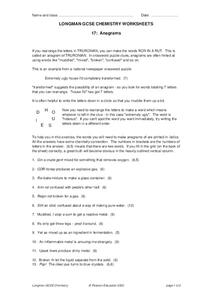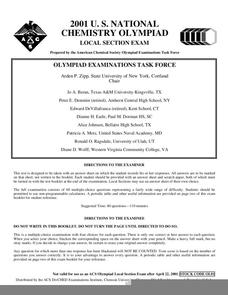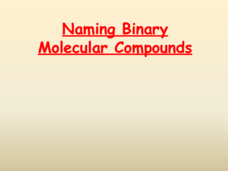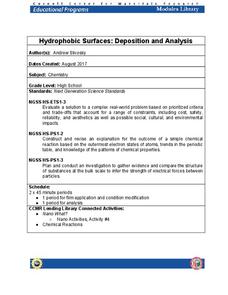Curated OER
Atom Basics Review Sheet
In this atom worksheet, students fill in three charts using the periodic table to identify atomic number, atomic mass, number of subatomic particles and the element's symbols. Students draw an atom and it's subatomic particles as well as...
Curated OER
Atoms, Molecules, and Ions
In this molecules learning exercise, students review the parts of an atom and use element mass to determine isotopes. Students give the group, period, and classification for the given elements. This learning exercise has 6 short answer...
Curated OER
Anagrams
In this chemistry worksheet, students complete a crossword puzzle by rearranging 13 anagrams about elements. They create their own anagrams from 3 given words.
Curated OER
Atoms
In this neutral atoms worksheet, students identify various neutral atoms found on the periodic table. They determine the number of protons, neutrons, and electrons for each neutral atom listed on the sheet. Students also identify that Z...
Curated OER
Changes in Nature
The goal of this science lesson is to have youngsters be able to identify the physical and chemical changes in the carbon cycle, and water cycle due to weathering. The in-class inquiry/experiment is quite interesting and easy to...
Curated OER
All About Circuits ~ Atomic Structure
In this interactive Internet assignment, physical science investigators answer 11 questions about the atom, the subatomic particles, and atomic structure. They can click on "Reveal Answer" to discover if they are correct. They also...
Curated OER
Atomic Structure and Ionic Bonding (A Visual Approach)
Using toothpicks, marshmallows, and round colored sticky dots, physical science enthusiasts build models of an atomic nucleus. In this eighth grade chemistry lesson plan, they play an atom-naming game with the models that they have...
Kenan Fellows
Determining the Atomic Mass of Elements in a Compound Using Matrices
Scholars apply concepts learned in both Algebra II and Chemistry to answer the questions on the provided worksheet. The activity allows for extra practice in both classes and helps connect concepts usually taught in isolation. The...
Curated OER
2001 U.S. National Chemistry Olympiad - Local Section Exam
Sixty multiple-choice chemistry questions make up this comprehensive exam used for the 2001 US National Chemistry Olympiad. Every topic that you would expect to approach in a general chemistry class is queried on. You could easily use...
Curated OER
Elements
In this elements worksheet, students write the electron configurations for given elements. Students describe ionization energy and electron affinity and the periodic trends for both. This worksheet has 20 short answer questions.
Curated OER
Learning Outcomes
In this science worksheet, learners explore the learning outcomes for a unit on chemical reactions. Students define 60 vocabulary words and answer a list of questions for each topic.
Curated OER
If I Was a...? Worksheet: Chemical Elements
In this element worksheet, students choose an element from the Periodic Table. Students pretend they are the element and answer the questions.
Curated OER
Main Group: Properties and Reactivity
In this main group instructional activity, students apply their knowledge of the organization of the periodic table to correctly answer 30 multiple choice questions. Students relate information about the properties of the different...
Curated OER
Advertise Your Family
In this periodic table worksheet, students create an advertisement for a chemical group or family they are assigned. They need to include topics such as are the elements solids, liquids or gases at room temperature, the history of the...
Curated OER
Electron Arrangement Worksheet
In this electron worksheet students complete an orbital diagram and electron configuration using a set of chemicals on the periodic table.
Curated OER
General Science Quiz
In this science activity, students write short answers for questions on planets, oceans, elements, and more. Students complete 20 questions.
Curated OER
Group 13: The Boron Family
A short slide show to display the characteristics of group 13 on the periodic table of elements. The atomic structure and reasons for their physical and chemical characteristics are not explained, and so this would only be an...
Curated OER
Defining the Atom
Words, words, words! This presentation uses plenty of them to define the atom, outline the history of what we know about atoms, and explain atomic and mass numbers. That's all! Informative, but not interesting, this slide show would be...
Curated OER
Groups 1 & 2, the Alkali Metals and the Alkaline Earth Metals
Giving a clear review of the basic properties of the metals in groups one and two on the periodic table, this slide show would be useful for early learners of chemistry. Your class will learn about the trends down the groups, such as...
Curated OER
# 21 Measuring Nitrate by Cadmium Reduction
Students design an experiment to evaluate the effects of various treatments on the nitrogen cycle in a freshwater aquarium. They are required to maintain a laboratory notebook of all work, measure the key analytes of the biosystem at...
Science Geek
Naming Binary Molecular Compounds
She has been reading that book about helium all day; she just can't put it down! Presentation begins with the rules for naming binary molecular compounds using prefixes and suffixes. After a list of prefixes for review, it offers guided...
Chemistry Teacher
Metals, Nonmetals, and Metalloids Lab
What an exciting way to introduce your blossoming chemists to the world of metals, nonmetals, metalloids, and polymers! Here is a lab activity that is designed to allow pupils the opportunity to visualize the reaction of metals,...
Cornell University
Hydrophobic Surfaces—Deposition and Analysis
Couches, carpets, and even computer keyboards now advertise they are spill-resistant, but what does that mean? Scholars use physical and chemical methods to coat surfaces with thin films to test their hydrophobic properties. Then they...
Curated OER
Mass/Mass Problems
In this mass worksheet, students calculate how much of any product will form from a given amount of reactant. This worksheet has 7 problems to solve.

























